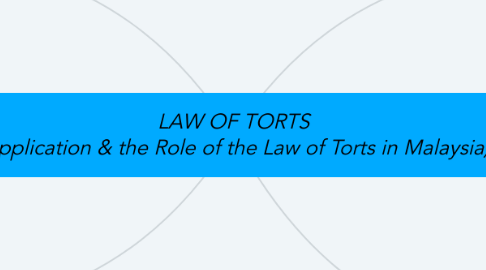LAW OF TORTS (Application & the Role of the Law of Torts in Malaysia)
by Muhammad Syahrul aqmal

1. TORTIOUS LIABILITY
1.1. Liability in tort happens when a person does something that wasn't authorized, and therefore does not do something that is required, by the law.
1.2. Tortious liability as a result of the breach of duty that has been approved by law. This duty is normally due to the public, the breach of which may be fixed by an action for damages in the form of claiming damages.
2. INTENTION •Intention is a state of mind and may be deduced from a person’s conduct in two ways:
2.1. Where a person is aware of the risks of his actions and hopes to fall to the petitioner for all those risks.
2.2. The natural and probable consequences of the act have been presumed to be intended. Thus, the defendant whose conduct is reasonable to give rise to some infringement of the plaintiff's interest is said to have the intention to commit the act in question.
3. MOTIVE AND MALICE
3.1. • MOTIVE. A motive is a person’s state of mind that inspires him to do an act. It usually means the purpose of the act’s commission.
3.2. •MALICE -When an act is done with bad intention, called Malice. -In the legal sense, it means’ intentional wrongdoing, without a just cause or excuse or a lack of a reasonable or probable cause’ and it is known as ‘malice in law’ .
4. DAMAGE
4.1. Tort such as negligence, nuisance, strict liability and defamation require proof or damage or harm before the defendant held liable. Namely damage in the form of physical injuries, damage to property, damage to reputation or economic loss.
5. DAMAGES
5.1. Damages means the monetary compensation that the defendant is ordered to pay to the plaintiff:
5.2. • Unliquidated damages: that are payable for a breach of contract, the exact amount of which has not been pre-agreed which includes general damages for pain and suffering. •Liquidated damages: specific damage that the plaintiff has suffered, for instance loss or earnings and medical bills.
6. LIMITATION
6.1. • actions in contract and tort shall not be brought after the expiration of six years from the date on which the cause of action accrued. •Failure to comply with the limitation period would be fatal to the plaintiff’s case as limitation operates as an absolute defence for the defendant.


